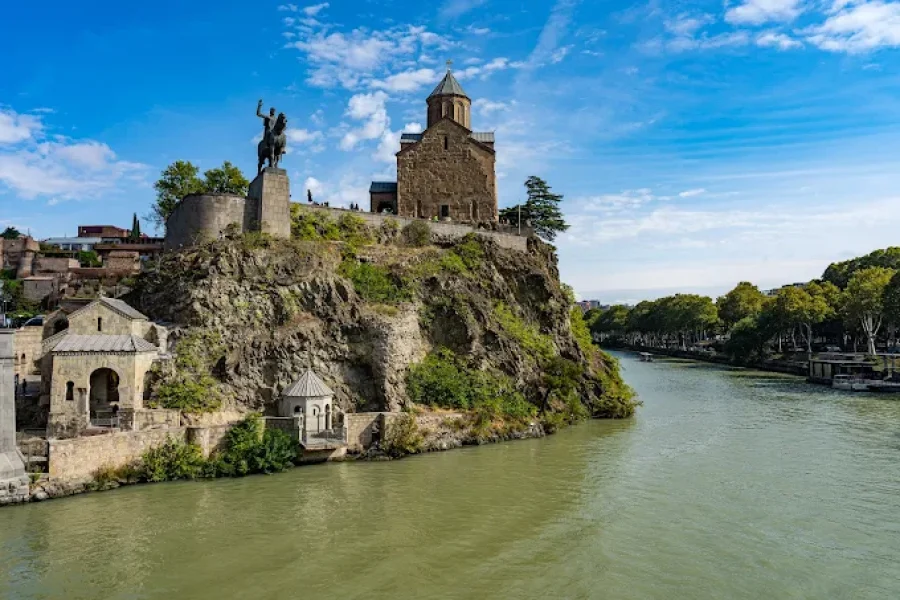Narikala: The Soul and History of Tbilisi in a Single Glance
If you want to feel the entire history, character, and beauty of Tbilisi in a single moment, the place to go is Narikala Fortress. This isn’t just an old fortification; it is the heart of the city, which has been beating steadily for centuries on the high Sololaki Ridge, overlooking colorful balconies, the domes of the sulfur baths, and the eternal flow of the Mtkvari River. To stand on Narikala is to stand where it all began.
The first stones of the fortress were laid here in the 4th century, when it was called “Shuris-tsikhe” (the Invidious Fort). Imagine, these walls remember the footsteps of the first Georgians, Persians, Arab emirs, the warriors of David the Builder, and Mongol invaders. It was the Mongols who named it “Narin Qala,” or “Little Fortress,” a name that has survived to this day. The name seems almost ironic when you consider its grandeur and immense historical significance.
Narikala has always been at the epicenter of conflict. To capture it meant to rule Tbilisi. It was the city’s last refuge and a symbol of its freedom. However, its greatest enemy proved to be not a foreign invader, but time and misfortune. In 1827, an explosion at a Russian garrison’s gunpowder depot almost completely destroyed the fortress, turning it into the silent, romantic ruins we see today.
But Narikala never truly fell. Its walls, though damaged, still stand proudly. The newly restored St. Nicholas Church, nestled within them, symbolizes the fortress’s spiritual rebirth. Coming here means you are not just visiting a historical monument; you are touching the living memory of the city.
The view from Narikala is history itself. From here, you can see how old and new Tbilisi merge, how different cultures and eras coexist. It is the single frame that best describes Tbilisi—a city that, like its fortress, has been destroyed many times but has always managed to rise from the ashes, even more beautiful and resilient.
🗺️ Geography & Location
Exact Location:
Narikala Fortress is situated above Old Tbilisi on the Sololaki Ridge, between the Tbilisi Botanical Garden and the sulfur baths.
Strategic Placement:
The fortress perfectly controlled the historic center of the city and the main trade and transit routes that passed through the Mtkvari valley.
Coordinates:
Approximately 41.6879° N, 44.8075° E.
📖 History & Background
Date of Construction & Origins:
The original version of the fortress, “Shuris-tsikhe,” was built in the 4th century. It was significantly expanded in the 7th-8th centuries by Arab emirs and later by King David the Builder.
Historical Role:
Narikala was the main defensive structure of Tbilisi, the royal citadel, and the residence of the city’s rulers.
Important Events:
It has withstood numerous sieges and battles. Since the 13th century, it has been known as “Narikala.” An explosion in 1827 severely damaged it. In the 1990s, the 12th-century St. Nicholas Church within its territory was restored.
Status:
It is a cultural monument of national significance in Georgia and the calling card of Tbilisi.
🏗️ Architecture & Design
Materials Used:
Built from local stone. The walls clearly show construction layers from different periods.
Key Features:
It consists of an upper and a lower fortress. Surviving structures include the defensive walls, towers, the ruins of the citadel, and the St. Nicholas Church. The remains of a 12th-century bathhouse have been discovered in the lower courtyard.
Unique Aspects:
Its architectural charm lies in its diverse history. Every ruling era left its mark, making it a kind of architectural chronicle.
🌟 Cultural & Tourist Significance
Legends and Stories:
Narikala is an integral part of the legend of Tbilisi’s founding. It is a symbol of the city’s invincibility and constant renewal.
Religious Importance:
The restored St. Nicholas Church is active and makes the site an important spiritual center.
Current Use:
It is one of the most visited sites in Tbilisi. It is ideal for history lovers, photographers, and anyone who wants to enjoy the best views of the city.
🚶 How to Visit
Best Time of Year to Visit:
It is beautiful in any season, but it is particularly stunning at sunrise or sunset when the city is bathed in golden light.



Leave a review